- Home
- About Journals
-
Information for Authors/ReviewersEditorial Policies
Publication Fee
Publication Cycle - Process Flowchart
Online Manuscript Submission and Tracking System
Publishing Ethics and Rectitude
Authorship
Author Benefits
Reviewer Guidelines
Guest Editor Guidelines
Peer Review Workflow
Quick Track Option
Copyediting Services
Bentham Open Membership
Bentham Open Advisory Board
Archiving Policies
Fabricating and Stating False Information
Post Publication Discussions and Corrections
Editorial Management
Advertise With Us
Funding Agencies
Rate List
Kudos
General FAQs
Special Fee Waivers and Discounts
- Contact
- Help
- About Us
- Search

The Open Systems Biology Journal
(Discontinued)
ISSN: 1876-3928 ― Volume 5, 2014
Kinetic Studies on Alcoholic Fermentation Under Substrate Inhibition Conditions Using a Bioreactor with Stirred Bed of Immobilized Yeast Cells
Anca-Irina Galaction1, Anca-Marcela Lupăşteanu2, Dan Caşcaval2, *
Abstract
The studies on the alcoholic fermentation with immobilized S. cerevisiae cells on alginate using a bioreactor with stirred beds of biocatalysts indicated that the diffusion inside the biocatalyst particles attenuates or avoids the inhibitory effects, preserving the microbial activity. Using a mathematical model adequate for ethanol formation in heterogeneous systems the kinetic parameters V, KI and K’M have been estimated. Therefore, the obtained values of V and K’M were found to be higher than those corresponding to the homogeneous media under ethanol inhibition, but lower than those for homogeneous media without inhibitory fenomena.
Article Information
Identifiers and Pagination:
Year: 2010Volume: 3
First Page: 9
Last Page: 20
Publisher Id: TOSYSBJ-3-9
DOI: 10.2174/1876392801003010009
Article History:
Received Date: 5/3/2010Revision Received Date: 30/3/2010
Acceptance Date: 12/4/2010
Electronic publication date: 29/4/2010
Collection year: 2010
open-access license: This is an open access article licensed under the terms of the Creative Commons Attribution Non-Commercial License (http: //creativecommons.org/licenses/by-nc/3.0/) which permits unrestricted, non-commercial use, distribution and reproduction in any medium, provided the work is properly cited.
* Address correspondence to this author at the Technical University “Gheorghe Asachi” of Iasi D. Mangeron 71, 700050 Iasi, Romania; Fax: 0040232271311; E-mail: dancasca@ch.tuiasi.ro, dancasca@from.ro
| Open Peer Review Details | |||
|---|---|---|---|
| Manuscript submitted on 5-3-2010 |
Original Manuscript | Kinetic Studies on Alcoholic Fermentation Under Substrate Inhibition Conditions Using a Bioreactor with Stirred Bed of Immobilized Yeast Cells | |
INTRODUCTION
The “white biotechnology”, the new concept promoted at the International Conference “European Bioperspectives - En Route to a Knowledge-Based Bio-Economy” (Cologne, Germany, May 31 - June 1 2007), proclaims that the use of renewable raw materials for biofuels production by low-expensive and ecofriendly biotechnologies constitutes one of the priority of industrial activities [1].
Among the tested and currently used biofuels, the bioethanol represents an attractive alternative to the conventional fossil fuels, its production by converting various substrates by free or immobilized cells of bacteria (Clostridium sp.) or yeasts (Saccharomyces sp., Zymomonas sp.) being intensively studied in the last two decades [2-5].
The fermentation with immobilized cells avoids the substrate inhibition, in these systems the use of higher concentration of carbohydrates becoming poosible, allows the easier recovery of biocatalysts and attenuates the reduction of the microbial activity. Therefore, the biocatalysts can be reused for many fermentation cycles [1,3,5].
Among the bioreactors with immobilized biocatalysts, those with stirred/mobile beds are the most attractive ones, owing to their constructive and operational similitude to the well-known stirred bioreactors. But, as it can be observed from literature, most of the experiments on alcoholic fermentation with immobilized cells have been carried out in fixed bed bioreactors in continuous, semicontinuous or fed-batch systems [2-3]. The fixed beds of immobilized cells have been preferred due to the higher sensitivity of the immobilized cells or enzymes to the forces generated by the impellers.
Our previous studies on alcoholic fermentation performed in a bioreactor with stirred beds of immobilized S. cerevisiae cells in alginate indicated that it is possible to reach very efficient mixing without or with minimum loss of biocatalyst physical integrity by selecting the optimum impellers combination [14-16]. These studies have been dedicated to the analysis of the medium circulation for different biocatalysts particles sizes and volumetric fractions using seven types of radial impellers. The results have been directly correlated with the shear effects on the immobilized cells particles [17].
The previous experiments are continued by investigating the kinetics of alcoholic fermentation of glucose under substrate inhibition limitation and by developing a mathematical model describing the internal diffusion of the substrate and, implicitly, the distribution of substrate concentration inside the biocatalysts particle. In this paper, the kinetic study of glucose conversion into ethanol is presented.
MATERIALS AND METHODOLOGY
The experiments have been carried out in 5 l (4 l working volume) laboratory bioreactor (Biostat A, B. Braun Biotech International), with computer-controlled and recorded parameters [18].
The mixing equipment consists of two pitched bladed turbines of 64 mm diameter and three baffles. The inferior impeller has been placed at 64 mm from the bioreactor bottom. The superior impeller was placed on the same shaft at a distance of 32 mm from the inferior one. The rotation speed was maintained at 250 rpm, thus value avoiding the “cave” formation at the broths surface, solid phase deposition at the bioreactor bottom and mechanical disruption of the biocatalysts particles. According to the previous results, these impellers combination and rotation speeds were found to be the optimum ones for the investigated fermentation system [14-17]. Any mechanical damage of the biocatalyst due to the shear forces was recorded during the experiments.
In the experiments, immobilized S. cerevisiae cells in alginate have been used. The immobilization has been carried out by cells inclusion into the alginate matrix, respecting the method given in literature [8]. The following diameters of the biocatalyst spherical particles have been obtained: 4, 4.6 and 5.2 mm. The volumetric fraction of the immobilized cells into the medium was varied between 0.07 and 0.40
The composition of the medium was: glucose 50, 100 or 150 g/l, KH2PO4 5 g/l, (NH4)2SO4 2 g/l, MgSO4 0.2 g/l, yeast extract 2 g/l, tap water to the prescribed volume [19]. The fermentations have been carried out until the entire amount of glucose was consumed, at 28oC.
The process evolution has been analyzed by means of the variation of glucose and ethanol concentrations during the fermentation. The concentrations of the two compounds have been measured by high performance liquid chromatography technique (HPLC) with a Phenomenex Rezex ROA column (7.8 mm diameter, 300 mm length), provided with the refractive index detector RID-10A. The mobile phase was a solution of 5x10-3 N sulfuric acid with a flow rate of 0.6 ml/min. The analysis temperature was of 65oC.
RESULTS AND DISCUSSION
1. Glucose Consumption
The bacteria or yeasts posses the ability to converse glucose under anaerobic conditions by Embden-Mereyhof-Parnas metabolic pathway, the main final products being the ethanol and carbon dioxide [20,21]. The efficiency of ethanol production by yeasts can be affected by glucose or ethanol concentration, due to the specific phenomenon of substrate or product inhibition. In these circumstances, the viability of S. cerevisiae population, the substrate consumption and ethanol biosynthesis rates are directly controlled by the cultivation conditions. An interesting result has been obtained by Nagodawithana and Steinkraus, the authors concluding that the addition of ethanol in a culture of S. cerevisiae induces less toxic effect than that generated by ethanol biosynthesized during the fermentation, the cells death occurring with lower rate in the former case [22]. This result could be explained by the presence of other metabolic products beside ethanol, these secondary products contributing to the amplification of the inhibitory phenomenon.
The experimental studies presented in this paper have been carried out at various glucose concentrations into the medium, some of them higher than the level generating the substrate inhibition for the fermentation systems with free yeast cells. Because the previous studies indicated that the optimum biocatalyst diameter from the viewpoint of mixing efficiency and particle mechanical lysis is that of 4.6 mm, the results will be analyzed in relation with this size of particle.
The initial analysis of the results plotted in Figs. (1 -3
-3 ) suggests that the immobilized yeast cells can be used for several fermentation cycles, the magnitude of the modification of biocatalyst activity being correlated with the particles characteristics and substrate initial concentration.
) suggests that the immobilized yeast cells can be used for several fermentation cycles, the magnitude of the modification of biocatalyst activity being correlated with the particles characteristics and substrate initial concentration.
 |
Fig. (1) Variation of glucose concentration for biocatalyst particles diameter of 4.6 mm. |
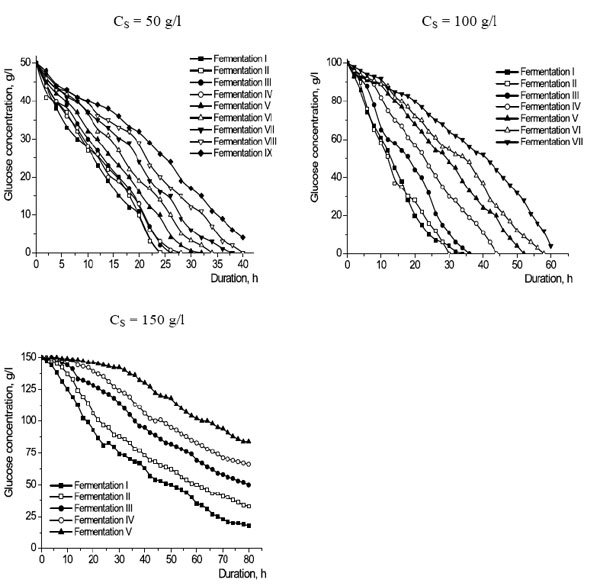 |
Fig. (2) Variation of glucose concentration for biocatalyst particles diameter of 4 mm and ϕ=0.07. |
 |
Fig. (3) Variation of glucose concentration for biocatalyst particles diameter of 5.2 mm and ϕ=0.07. |
For biocatalyst particles with 4.6 mm diameter and lower volumetric fraction (ϕ = 0.07), at an initial glucose concentration of 50 g/l, the duration of the first fermentation is of 26 h (necessary for the total consumption of glucose) (Fig. 1 ). Any important modification of the yeast activity has been observed during the first four fermentation cycles, but the glucose consumption rate decreases and, implicitly, the process duration increases significantly from the fermentation V to IX. Therefore, the duration of fermentation IX becomes of 50 h, but other few fermentation cycle could be performed until reaching 72 h (this duration is required for the primary, main and complementary alcoholic fermentation with free S. cerevisiae cells).
). Any important modification of the yeast activity has been observed during the first four fermentation cycles, but the glucose consumption rate decreases and, implicitly, the process duration increases significantly from the fermentation V to IX. Therefore, the duration of fermentation IX becomes of 50 h, but other few fermentation cycle could be performed until reaching 72 h (this duration is required for the primary, main and complementary alcoholic fermentation with free S. cerevisiae cells).
The increase of the initial glucose concentration to 100 g/l does not change the shape of the plotted variations, but it extends the time interval needed for reaching the total consumption of substrate. According to Fig. (1 ), the fermentation duration increases from 38 h, cycle I, to 70 h, cycle VII. Moreover, only the first two fermentation cycles occurred similarly, the variations of glucose concentration becoming differentiated after the second cycle.
), the fermentation duration increases from 38 h, cycle I, to 70 h, cycle VII. Moreover, only the first two fermentation cycles occurred similarly, the variations of glucose concentration becoming differentiated after the second cycle.
The utilization of 150 g/l glucose, level that corresponds to the appearance of the evident substrate inhibition, does not inhibit the activity of the immobilized yeast cells (Fig. 1 ). Furthermore, the amounts of converted substrate for a certain time interval are rather equal, indifferent of its concentration in medium. This result suggests that the substrate inhibition is avoided by cells immobilization, owing to the internal diffusion of the substrate inside the biocatalyst particles which reduces the inner glucose concentration bellow that inducing the inhibition.
). Furthermore, the amounts of converted substrate for a certain time interval are rather equal, indifferent of its concentration in medium. This result suggests that the substrate inhibition is avoided by cells immobilization, owing to the internal diffusion of the substrate inside the biocatalyst particles which reduces the inner glucose concentration bellow that inducing the inhibition.
Starting from an initial substrate concentration of 150 g/l, the fermentation duration is significantly increased (from 100 to 160 h from fermentation I to V), simultaneously with the amplification of the differences between the glucose consumption rates from one fermentation cycle to another.
The above conclusions are valid also for higher biocatalyst particles concentration in bioreactor, but the duration of the fermentation is considerably reduced. Thus, from Fig. (1 ) it can be seen that for ( = 0.40, 50 g/l glucose is entirely consumed in 20 h, 100 g/l glucose in 26 h, 150 g/l glucose in 62 h, respectively. Moreover, indifferent of the initial substrate concentration, nine fermentation cycles are possible before reaching the overall process duration corresponding to the fermentation with free S. cerevisiae cells, the recorded variations of glucose concentration being closer.
) it can be seen that for ( = 0.40, 50 g/l glucose is entirely consumed in 20 h, 100 g/l glucose in 26 h, 150 g/l glucose in 62 h, respectively. Moreover, indifferent of the initial substrate concentration, nine fermentation cycles are possible before reaching the overall process duration corresponding to the fermentation with free S. cerevisiae cells, the recorded variations of glucose concentration being closer.
Although for biocatalyst particles with diameters of 4 and 5.2 mm the shape of the curves describing the variation of glucose concentration during the fermentation and the conclusions drawn from their analysis are rather similar to those above discussed, different glucose consumption rates can be observed in function of biocatalyst particles characteristics. Therefore, for the smallest particles and volumetric fraction of 0.07, at glucose initial concentration of 50 g/l the fermentation duration is inferior to that reached for particles with 4.6 mm diameter, the time needed for total consumption of the substrate varying between 24 h, for fermentation I, and 45 h, for fermentation IX (Fig. 2 ). The acceleration of the process rate is maintained also for glucose concentration of 100 g/l, the maximum fermentation duration being of 62 h for the seventh cycle.
). The acceleration of the process rate is maintained also for glucose concentration of 100 g/l, the maximum fermentation duration being of 62 h for the seventh cycle.
The ratio between the substrate consumption rates recorded for the biocatalyst particles diameters of 4 and 4.6 mm is changed for a medium initially containing 150 g/l glucose (Fig.2 ). In this case, the utilization of the smallest particles increases the time required for the entire glucose consumption. This inversion is the consequence of the more important resistance to the diffusion of glucose inside the biocatalyst for the particles with 4.6 mm diameter. The magnitude of resistance to the internal diffusion is directly related to the particle size and controls the glucose concentration gradient between the inner and outer regions of the particle. Thus, this gradient is increased by reducing the internal diffusion velocity, and, consequently, the internal concentration of substrate could be lower than that inducing the inhibition phenomenon for the biocatalyst particles with diameter of 4.6 mm.
). In this case, the utilization of the smallest particles increases the time required for the entire glucose consumption. This inversion is the consequence of the more important resistance to the diffusion of glucose inside the biocatalyst for the particles with 4.6 mm diameter. The magnitude of resistance to the internal diffusion is directly related to the particle size and controls the glucose concentration gradient between the inner and outer regions of the particle. Thus, this gradient is increased by reducing the internal diffusion velocity, and, consequently, the internal concentration of substrate could be lower than that inducing the inhibition phenomenon for the biocatalyst particles with diameter of 4.6 mm.
If the biocatalyst particles with 5.2 mm diameter are used, the time needed for total glucose consumption is increased to 78 h, for fermentation IX at initial substrate concentration of 50 g/l, and over 80 h, for fermentation VII at initial substrate concentration of 100 g/l, respectively (Fig. 3 ). Compared to the previous biocatalyst particles sizes, the glucose consumption from 150 to 0 g/l is accelerated in the case of the biggest particles. After 80 h from the fermentation start, the glucose concentration reached the values of 16 g/l for cycle I, respectively 64 g/l for cycle V, values that are significant lower that those recorded for the other two sizes of biocatalyst particles (Fig.3
). Compared to the previous biocatalyst particles sizes, the glucose consumption from 150 to 0 g/l is accelerated in the case of the biggest particles. After 80 h from the fermentation start, the glucose concentration reached the values of 16 g/l for cycle I, respectively 64 g/l for cycle V, values that are significant lower that those recorded for the other two sizes of biocatalyst particles (Fig.3 ). This result confirms that the internal diffusion contributes decisively to the diminution of the inhibitory effect of glucose. But, in this case, the product inhibition could become important, due to the low diffusion rate of ethanol towards the outer medium and to its accumulation inside the particle. However, the experiments indicated that the substrate inhibition represents the main phenomenon affecting the fermentation performance compared to the product inhibition.
). This result confirms that the internal diffusion contributes decisively to the diminution of the inhibitory effect of glucose. But, in this case, the product inhibition could become important, due to the low diffusion rate of ethanol towards the outer medium and to its accumulation inside the particle. However, the experiments indicated that the substrate inhibition represents the main phenomenon affecting the fermentation performance compared to the product inhibition.
These experiments have been carried out also at rotation speeds of 150, 200 and 300 rpm, but any important modification of the above variations have been observed. Therefore, it can be concluded that the diffusion of glucose through the boundary layer at the biocatalyst particles surface does not represent the limitative step of the substrate consumption process.
2. Ethanol Production
Evidently, the variation of ethanol concentration during the fermentation is directly correlated with that of glucose concentration (Figs. 4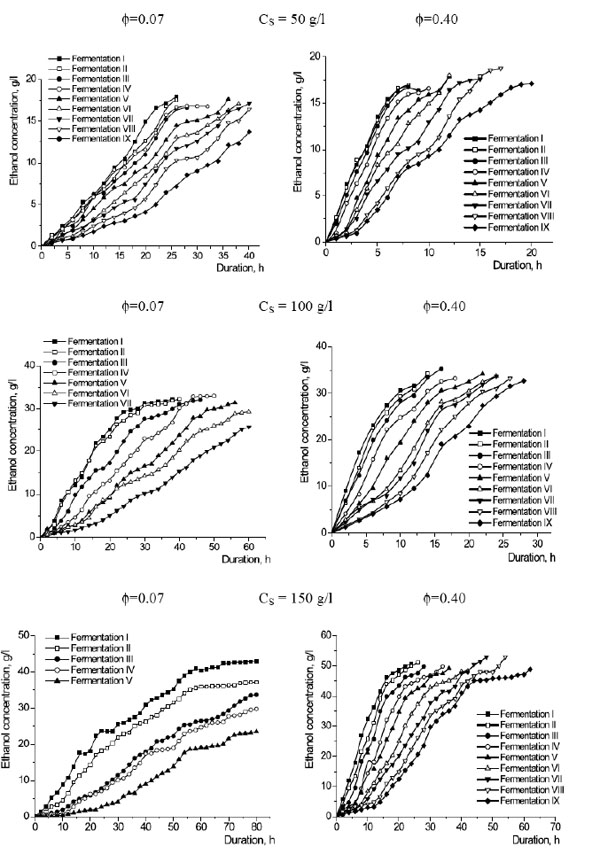 -6
-6 ). Furthermore, for a certain initial concentration of glucose, the values of ethanol concentration and fermentation duration are controlled by the size and concentration of biocatalyst particles.
). Furthermore, for a certain initial concentration of glucose, the values of ethanol concentration and fermentation duration are controlled by the size and concentration of biocatalyst particles.
 |
Fig. (4) Variation of ethanol concentration for biocatalyst particles diameter of 4.6 mm. |
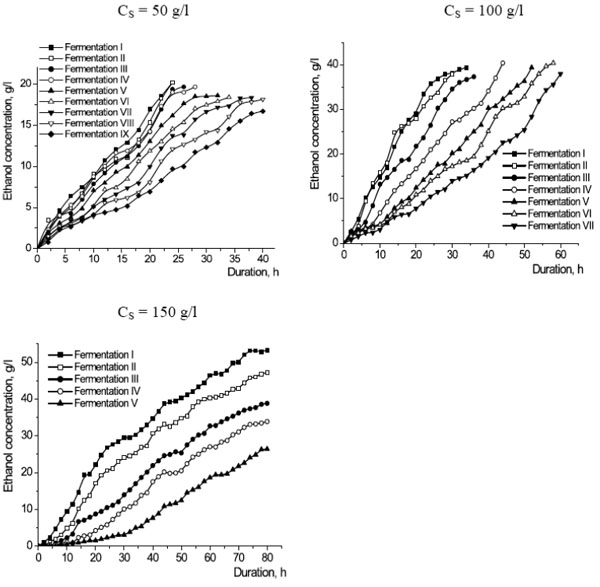 |
Fig. (5) Variation of ethanol concentration for biocatalyst particles diameter of 4 mm and ϕ=0.07. |
 |
Fig. (6) Variation of ethanol concentration for biocatalyst particles diameter of 5.2 mm and ϕ=0.07. |
As it was above discussed, the biocatalyst particles characteristics influence the glucose internal diffusion velocity and consumption rate. Theoretically, from 180 g glucose is produced 92 g ethanol, the theoretical yield of substrate conversion being:
The analysis of the variation of substrate conversion yield offers more suggestive information regarding the effect of cells immobilization on the ethanol production efficiency. In this context, Fig. (7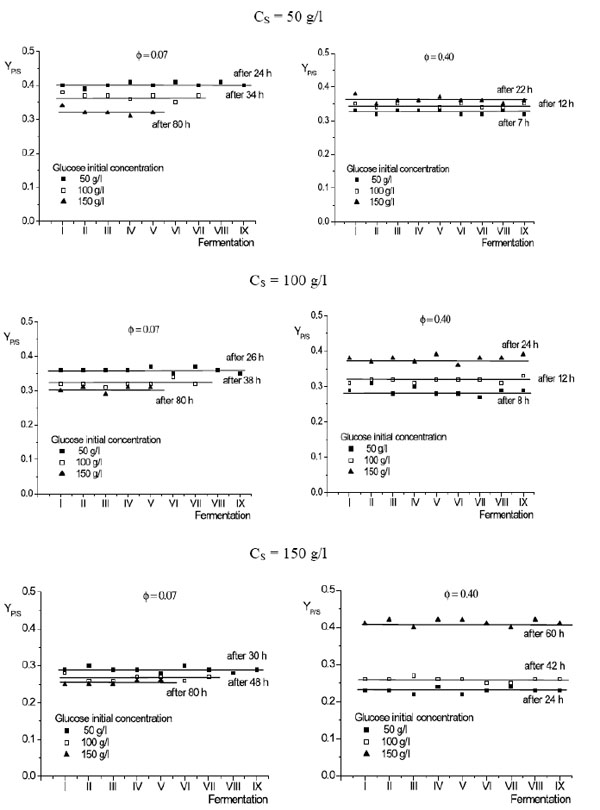 ) indicates the dependence of this parameter on the size and concentration of biocatalyst particles related to the duration of the first fermentation cycle.
) indicates the dependence of this parameter on the size and concentration of biocatalyst particles related to the duration of the first fermentation cycle.
 |
Fig. (7) Variation of glucose consumption yield. |
In all cases, the value of YP/S remains constant for a certain glucose concentration and biocatalyst characteristics, indifferent of the number of fermentation cycles. This result cumulated with the reduction of the fermentation rate by increasing the number of fermentation cycles suggest that the extension of the process duration does not lead to the formation of supplementary amounts of secondary compounds compared to the first cycle.
The influence of the biocatalyst particles size has to be correlated with their volumetric fraction. Thus, for the lowest volumetric fraction, ( = 0.07, for all considered sizes of the particles, the yield of substrate conversion decreases with the increase of glucose initial concentration from 50 to 150 g/l. Because the results have been related to the first fermentation duration, the variation of YP/S cannot be attributed to the increase of substrate concentration for the same amount of yeast cells. In these circumstances, the diminution of YP/S can be explained by the appearance and intensification of substrate inhibitory phenomenon. By increasing the particles size, and, therefore, by enhanced the importance of the internal diffusion resistance, the values of YP/S obtained for 150 g/l glucose become closer to those for lower substrate concentrations, due to the attenuation of the negative effect of substrate inhibition. This result supports the above conclusion.
The substrate conversion yield is reduced by enlarging the biocatalyst particles. This dependence is the consequence of the decrease of the substrate internal diffusion rate and of the increase of its concentration gradient between the surface and the inner regions of the particle. For ( = 0.07, YP/S varied from 0.26, for a particle diameter of 5.2 mm and initial glucose concentration of 150 g/l, to 0.40, for 4 mm diameter and 50 g/l glucose.
Although most of the above variations are valid also for more concentrated suspensions of biocatalyst particles, the increase of the glucose concentration exhibits a contrary effect on the substrate conversion yield (Fig.7 ). Due to the high amount of biocatalysts, the average glucose concentration inside the alginate particles is low, the increase of the substrate concentration having an important favorable influence on the fermentation performance.
). Due to the high amount of biocatalysts, the average glucose concentration inside the alginate particles is low, the increase of the substrate concentration having an important favorable influence on the fermentation performance.
3. Kinetic Parameters
The rate of the biochemical reactions in heterogeneous systems is lower than that recorded for homogeneous media, owing to the radial decreasing of the substrate concentration inside the biocatalyst particles. For the heterogeneous systems, not only the value of the biochemical reaction rate is affected, but also the kinetic model is modified compared to the ideal models describing the substrate consumption or product formation.
For these reasons, the kinetic parameters of the biochemical reactions which involve immobilized cells or enzymes differ from those corresponding to the homogeneous media. For the analyzed fermentation systems, the ethanol formation can be mathematically described by means of a modified Michaelis-Menten equation [20]:
The concentration of the yeast cells in medium is calculated with the expression:
The eq. (2) can be used for fermentation systems without inhibitory phenomena. But, as it was previously presented, although their magnitude was diminished by immobilization, the inhibitory effects occur also in the case of alcoholic fermentation with immobilized yeast cells, the most important being that induced by glucose. Therefore, taking into account the substrate inhibition, the Michaelis-Menten equation can be written for the immobilized cells as follows [23]:
The kinetic parameters, V, K’M and KI can be estimated by Linewever-Burk linearization method adapted to the studied conditions and considering K’M << CS:
Thus, by plotting the dependence between
For respecting the accuracy of the results and for avoiding the negative influence of the mechanical lysis of biocatalyst particles, the calculations have been made only for the first fermentation cycle. The ethanol production rate has been determined by means of the variations plotted in Fig. (8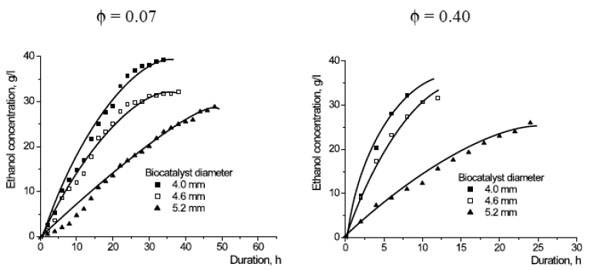 ).
).
 |
Fig. (8) Variation of ethanol concentration for the first fermentation cycle and 100 g/l glucose. |
The obtained straight lines are plotted in Figs. (9 , 10
, 10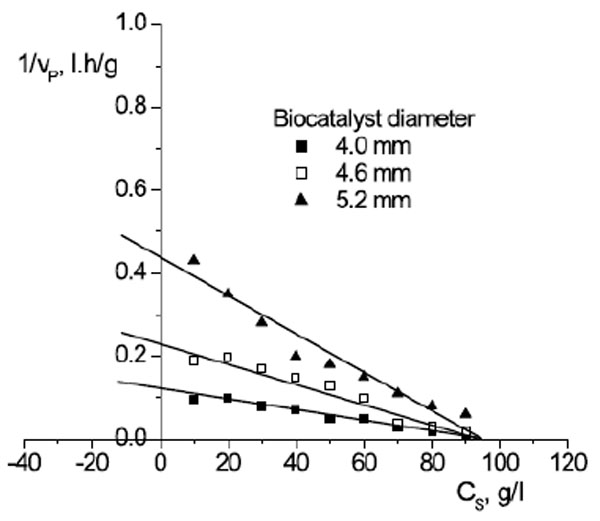 ) for two volumetric fractions of biocatalyst particles, 0.07 and 0.40, respectively. The obtained values are given in Table 1.
) for two volumetric fractions of biocatalyst particles, 0.07 and 0.40, respectively. The obtained values are given in Table 1.
 |
Fig. (9) Lineweaver-Burk plot for ϕ = 0.07. |
 |
Fig. (10) Lineweaver-Burk plot for ϕ = 0.40. |
These results indicate that the inhibition constant has an unique value indifferent of the biocatalyst particles size, but depending on their concentration. Thus, KI is decreased by increasing the particles volumetric fraction, result that suggests the attenuation of the inhibitory effect induced by glucose.
The apparent Michaelis-Menten constant is not influenced by the size and concentration of biocatalyst particles, its average calculated value being of 18.14 g/l.
The maximum rate of ethanol production is favorably influenced by the increase of the biocatalysts concentration, but is affected by their size enlargement. In this case, the increase of the particles volumetric fraction from 0.07 to 0.40 led to the acceleration of the maximum rate for 1.30 - 1.35 times, due to the increase of the amount of active cells in medium and to the diminution of the inhibitory effect magnitude. On the other hand, the enlargement of the particles from the diameter of 4 mm to 5.2 mm determined the reduction of maximum rate for about 2.8 times, as the result of the enhancement of the resistance to the internal diffusion of glucose.
By comparing these results to those reported by Aiba et al. for alcoholic fermentation with free S. cerevisiae cells under ethanol inhibition conditions [19], the following conclusions can be drawn:
- indifferent of the size of biocatalyst particles, the maximum rate of ethanol biosynthesis is superior to that reached for the homogeneous media containing 30 g/l ethanol, due to the attenuation of the inhibitory effect by the internal diffusion (V = 0.75 g/l obtained by Aiba, et al. [19]);
- the apparent Michaelis-Menten constant was significant greater than that obtained by Aiba et al. (K’M = 0.50 g/l), also due to the internal diffusion.
Besides the positive effect exhibited by the attenuation of the inhibitory phenomena, the immobilization of S. cerevisiae cells affects the fermentation rate compared to the systems without inhibition containing free yeast cells. Therefore, the kinetic studies on the alcoholic fermentation carried out by Hopkins and Roberts for media containing 100 g/l glucose and 10 g/l yeasts led to higher values of maximum rate, 21.3 g/l.h, and Michaelis-Menten constant, 1.92 g/l [24].
CONCLUSIONS
The studies on the substrate consumption and product formation rates during the alcoholic fermentation with immobilized S. cerevisiae cells and glucose substrate using a bioreactor with stirred beds of biocatalysts indicated the possibility to use these biocatalysts for five to over nine fermentation cycles, in function of the substrate concentration and biocatalyst characteristics. Moreover, due to the diffusion inside the biocatalyst particles, the inhibitory phenomena are avoided, the microbial activity being preserved.
Using a specific mathematical model for ethanol formation in the investigated systems, the kinetic parameters V, KI and K’M have been estimated and compared with their values previously reported for alcoholic fermentation in homogeneous media with or without inhibitory effects.
ACKNOWLEDGEMENT
This work was included in the Grant PNCDI II 21-048/2007 supported by the National Centre for Programs Management (CNMP)

